Georgia's past and its potential future converged in the tiny town of Plains, as former President Jimmy Carter campaigned Tuesday alongside Democratic gubernatorial hopeful Stacey Abrams.
Despite their starkly different biographies — he the 93-year-old peanut farmer who entered Deep South politics amid Jim Crow segregation, she the 44-year-old Atlanta attorney who'd be the first black female governor in U.S. history — the pair of Democratic politicians cited a shared interest in reversing the slide in rural health care services.
And Abrams hopes that emphasis can net her just enough improvement in heavily Republican rural Georgia to boost her chances of an upset over her GOP challenger, Brian Kemp, in a state that looks to be on the cusp of becoming a two-party battleground.

Former President Jimmy Carter and Democratic gubernatorial candidate Stacey Abrams speak to reporters during a news conference to announce her rural health care plan Tuesday, Sept. 18, 2018, in Plains, Ga. (AP PhotoJohn Bazemore)
"Rosalynn and I are fully supporting Stacey for governor, and I don't want anybody to be doubtful about that," Carter said, standing in front of his town's medical clinic, down the block from his 1976 presidential campaign headquarters.
"One of the main reasons is our deep concern about medical care in Georgia," Carter continued.
He and Abrams joined in a recitation of dire health care statistics as they chided Georgia's current Republican leadership, including Kemp, for opposing expansion of the Medicaid government insurance program for poor and low-income workers.

Former President Jimmy Carter speaks as Democratic gubernatorial candidate Stacey Abrams listens on during a news conference to announce her rural health care plan Tuesday, Sept. 18, 2018, in Plains, Ga. (AP PhotoJohn Bazemore)
Kemp's campaign did not immediately respond to a request for comment after the event.
More than a half dozen community hospitals have closed in Georgia in recent years under the weight of treating uninsured patients — treatments required by federal law. Abrams said that of Georgia's 159 counties, 79 have no obstetrician-gynecologist, 64 have no pediatrician, 76 are without a psychologist, 52 counties are without social workers, and nine counties have no physician of any kind. She said the largest provider of mental health services in the state is the prison system.
Carter said the situation "grieves me very much."
The answer, he and Abrams said, is accepting the federal government's offer of expanded Medicaid coverage, a deal that would require Georgia to put up 10 cents of every new Medicaid dollar spent, with the federal treasury covering the rest. Georgia, under outgoing Republican Gov. Nathan Deal, is among the 17 states to reject expansion, calling it too expensive.
Kemp takes the same posture, arguing that economic development and job growth will expand access to private insurance.
Abrams retorted Tuesday that economic development simply doesn't work that way in rural areas. "When we talk about bringing health care back to the South, back to rural Georgia, we're talking about creating opportunities for jobs in construction, jobs for pharmacies, jobs for cafe owners, jobs for gas station attendants," she said. "If we want to attract bigger jobs and bigger companies for rural Georgia, there has to be medical access available."
Yet those dynamics that Abrams emphasized Tuesday highlight her political challenge and the generations-long shift in Georgia voting habits since Carter's political prime: White voters in rural and small-town Georgia align overwhelmingly with Republicans.
When Carter was elected governor, Georgia had 4.6 million residents, fewer than a million of them living in cities and almost 1.8 million (about 40 percent) of them in rural areas. The 2010 census counted the state's rural residents at less than 2.5 million in an ever-growing state now estimated at 10.4 million people.
The Georgia of a previous generation gave Carter nearly 60 percent of the vote in both the Democratic primary runoff and the general election as he carefully navigated the racial politics of the era, campaigning for black votes but not explicitly eschewing segregationist Democrats until after he had won.
But white Georgians' shift to Republicans proceeded quickly under President Ronald Reagan, the man who ousted Carter from the White House in 1980. Carter managed to win Georgia in 1980, but four years later Reagan won more than 125 counties as part of his national landslide. The Democratic nominee has won Georgia just once since.
Democrats are buoyed this year, though, by a continued demographic shift in favor of an even younger, more urban and nonwhite electorate.
But, Abrams said, she still wants to prove that her agenda can appeal "for all of rural Georgia."
----
Follow Barrow on Twitter at https://twitter.com/BillBarrowAP .
VENICE, Italy (AP) — Under the gaze of the world’s media, the fragile lagoon city of Venice launches a pilot program Thursday to charge day-trippers a 5-euro (around $5.35) entry fee that authorities hope will discourage visitors from arriving on peak days and make the city more livable for its dwindling residents.
Signs advising arriving visitors of the new requirement for a test phase of 29 days through July have been erected outside the main train station and other points of arrival.
Some 200 stewards have been trained to politely walk anyone unaware of the fee through the process of downloading a QR code. A kiosk has been set up for those not equipped with a smartphone. Once past designated entry ports, officials will carry out random checks for QR codes that show the day-tripper tax has been paid or that the bearer is exempt.
Transgressors face fines 50 euros to 300 euros. The requirement applies only for people arriving between 8:30 a.m. and 4 p.m. Outside of those hours, access is free.
“We need to find a new balance between the tourists and residents,’’ said the city’s top tourism official, Simone Venturini. “We need to safeguard the spaces of the residents, of course, and we need to discourage the arrival of day-trippers on some particular days.”
Venice has long suffered under the pressure of over-tourism, but officials say that pre-pandemic estimates ranging from 25 million to 30 million visitors a year — including day-trippers — are not reliable and that the pilot project also aims to come up with more exact figures to help better manage the phenomenon.
By contrast, registered visitors spending the night last year numbered 4.6 million, according to city figures, down 16% from pre-pandemic highs.
Venturini said the city is strained when the number of day-trippers reaches 30,000 to 40,000. Its narrow alleyways are clogged with people and water taxis packed, making it difficult for residents to go about their business.
Not all residents, however, are persuaded of the efficacy of the new system in dissuading mass tourism, and say more attention needs to be paid to boosting the resident population and services they need.
Venice last year passed a telling milestone when the number of tourist beds exceeded for the first time the number of official residents, which is now below 50,000 in the historic center with its picturesque canals.
“Putting a ticket to enter a city will not decrease not even by one single unit the number of visitors that are coming,’’ said Tommaso Cacciari, an activist who organized a protest Thursday against the measure.
“You pay a ticket to take the metro, to go to a museum, an amusement park; you don’t pay a ticket to enter a city. This is the last symbolic step of a project of an idea of this municipal administration to kick residents out of Venice,” he said.
Venturini said about 6,000 people had already paid to download the QR code, and officials expect paid day-tripper arrivals Thursday to reach some 10,000.
More than 70,000 others have downloaded a QR code denoting an exemption, including to work in Venice or as a resident of the Veneto region. People staying in hotels in Venice, including in mainland districts like Marghera or Mestre, should also get a QR code attesting to their stay, which includes a hotel tax.
The tourist official says interest in Venice's pilot program has been keen from other places suffering from mass tourism, including other Italian art cities and cities abroad such as Barcelona and Amsterdam.
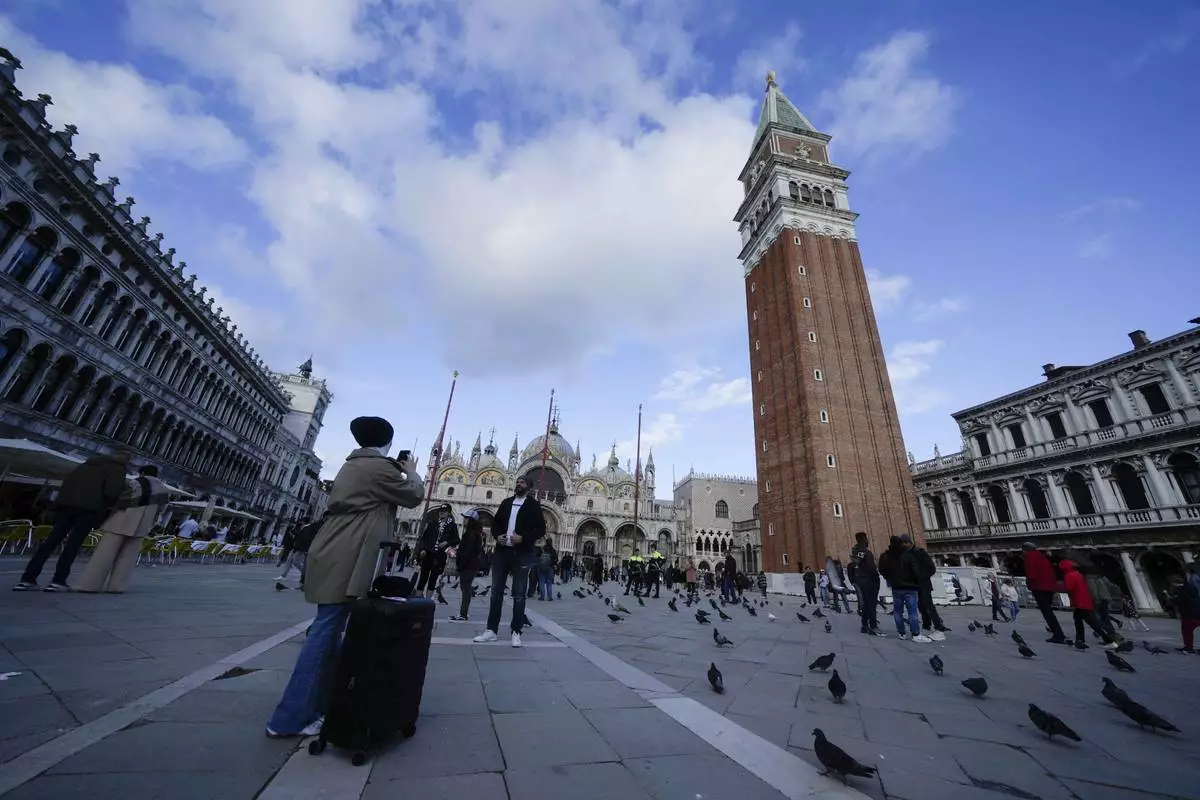
Tourists take pictures at the St. Mark square in Venice, Italy, Wednesday, April 24, 2024. The lagoon city of Venice begins a pilot program Thursday, April 25, 2024 to charge daytrippers a 5 euro entry fee that authorities hope will discourage tourists from arriving on peak days. Officials expect some 10,000 people will pay the fee to access the city on the first day, downloading a QR code to prove their payment. (AP Photo/Luca Bruno)
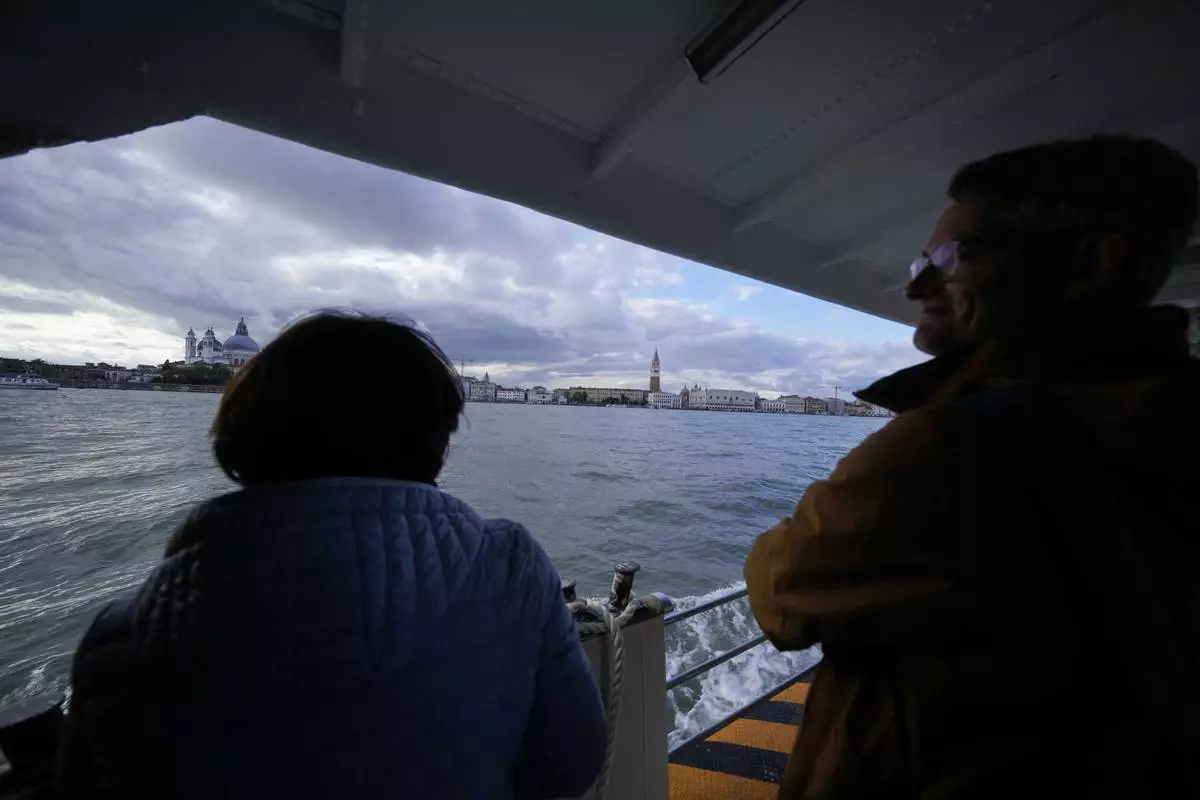
Tourists ride on a ferry boat in Venice, Italy, Wednesday, April 24, 2024. The lagoon city of Venice begins a pilot program Thursday, April 25, 2024 to charge daytrippers a 5 euro entry fee that authorities hope will discourage tourists from arriving on peak days. Officials expect some 10,000 people will pay the fee to access the city on the first day, downloading a QR code to prove their payment. (AP Photo/Luca Bruno)
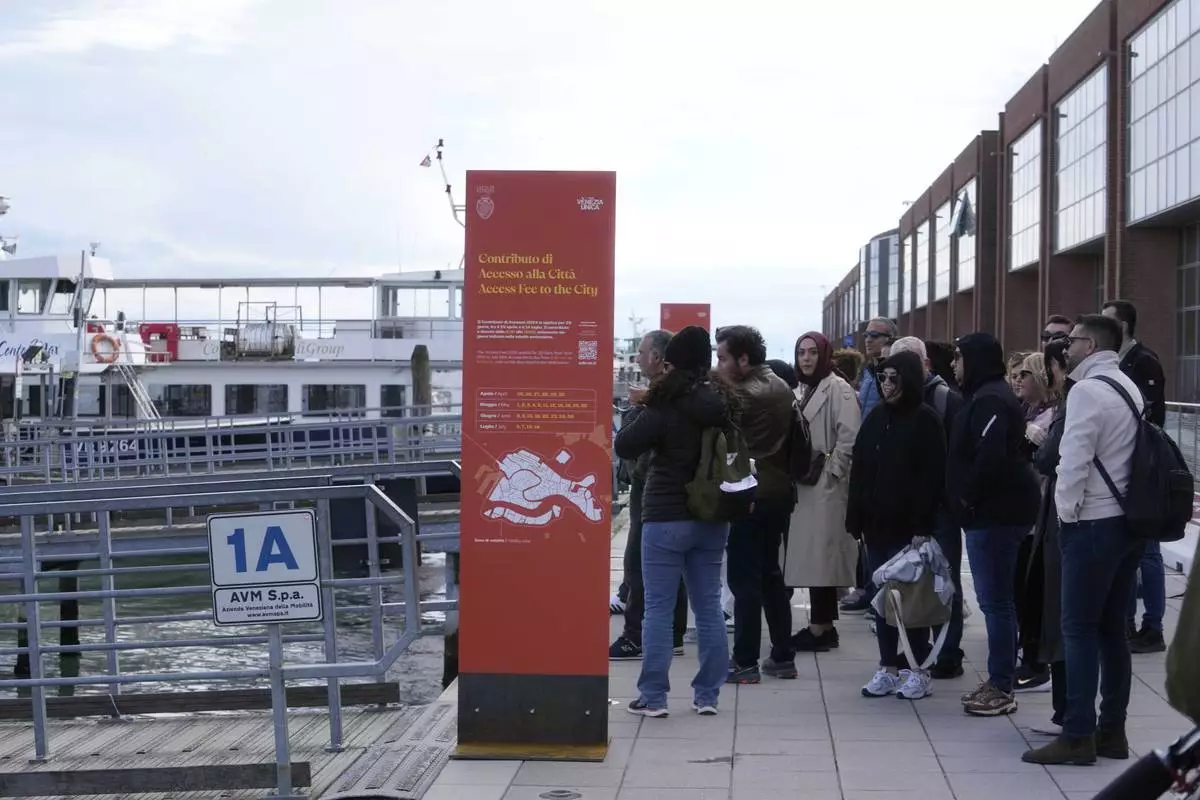
People stand in front of an information board explaining how to pay the tourist tax in Venice, Italy, Wednesday, April 24, 2024. The lagoon city of Venice begins a pilot program Thursday, April 25, 2024 to charge daytrippers a 5 euro entry fee that authorities hope will discourage tourists from arriving on peak days. Officials expect some 10,000 people will pay the fee to access the city on the first day, downloading a QR code to prove their payment. (AP Photo/Luca Bruno)
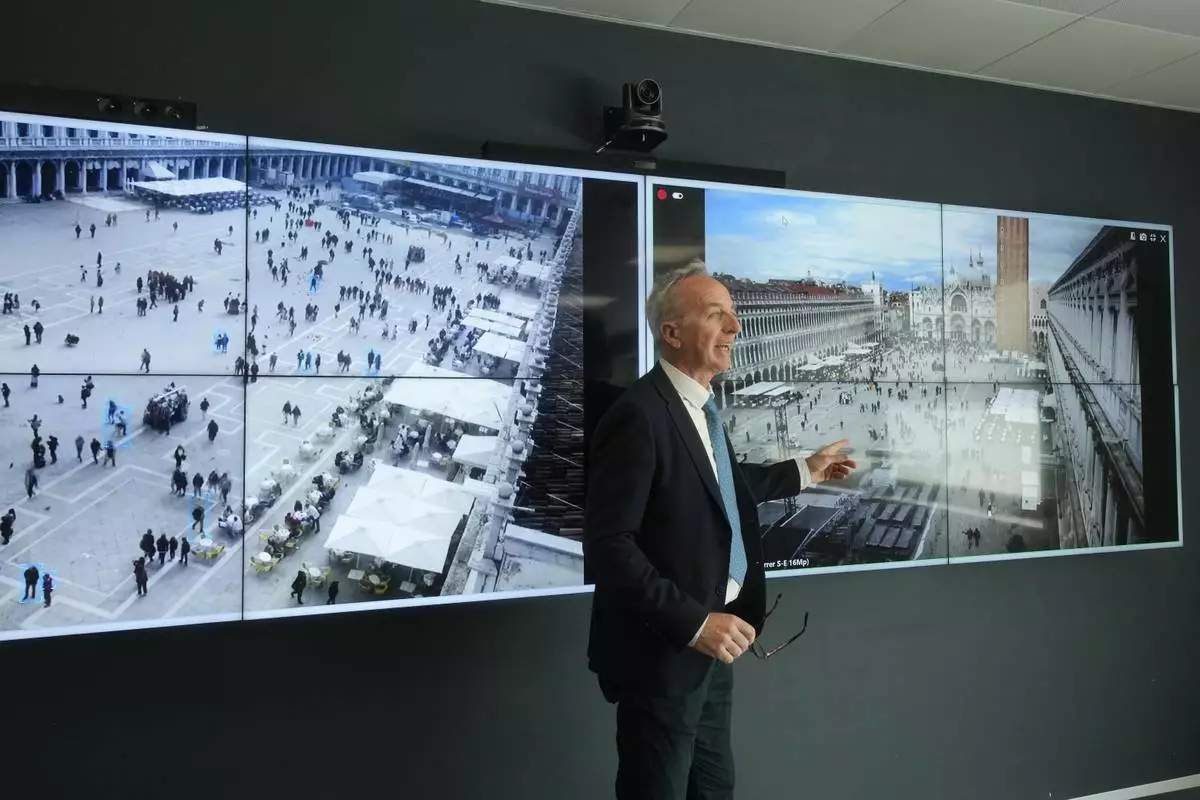
Marco Bettini, director of Venis Informatics System, gestures as he talks to reporters at the police Venice control room, in Venice, Italy, Wednesday, April 24, 2024. The lagoon city of Venice begins a pilot program Thursday, April 25, 2024 to charge daytrippers a 5 euro entry fee that authorities hope will discourage tourists from arriving on peak days. Officials expect some 10,000 people will pay the fee to access the city on the first day, downloading a QR code to prove their payment. (AP Photo/Luca Bruno)

Venice councillor Simone Venturini speaks with reporters in front of a tourist tax totem in Venice, Italy, Wednesday, April 24, 2024. The lagoon city of Venice begins a pilot program Thursday, April 25, 2024 to charge daytrippers a 5 euro entry fee that authorities hope will discourage tourists from arriving on peak days. Officials expect some 10,000 people will pay the fee to access the city on the first day, downloading a QR code to prove their payment. (AP Photo/Luca Bruno)
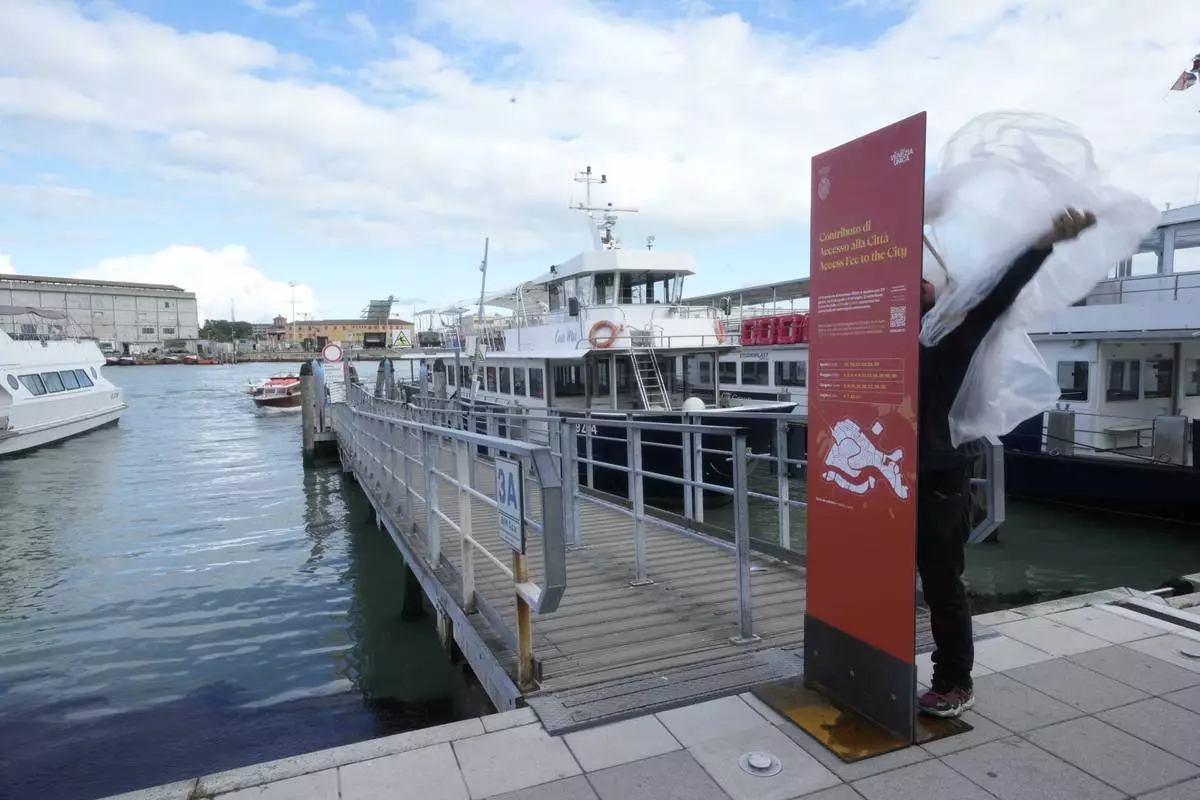
Workers prepare banner explaining how to pay the tourist tax in Venice, Italy, Wednesday, April 24, 2024. The lagoon city of Venice begins a pilot program Thursday, April 25, 2024 to charge daytrippers a 5 euro entry fee that authorities hope will discourage tourists from arriving on peak days. Officials expect some 10,000 people will pay the fee to access the city on the first day, downloading a QR code to prove their payment. (AP Photo/Luca Bruno)

Marco Bettini, director of Venis Informatics System, gestures as he explains the Venice density to reporters at the police Venice control room in Venice, Italy, Wednesday, April 24, 2024. The lagoon city of Venice begins a pilot program Thursday, April 25, 2024 to charge daytrippers a 5 euro entry fee that authorities hope will discourage tourists from arriving on peak days. Officials expect some 10,000 people will pay the fee to access the city on the first day, downloading a QR code to prove their payment. (AP Photo/Luca Bruno)
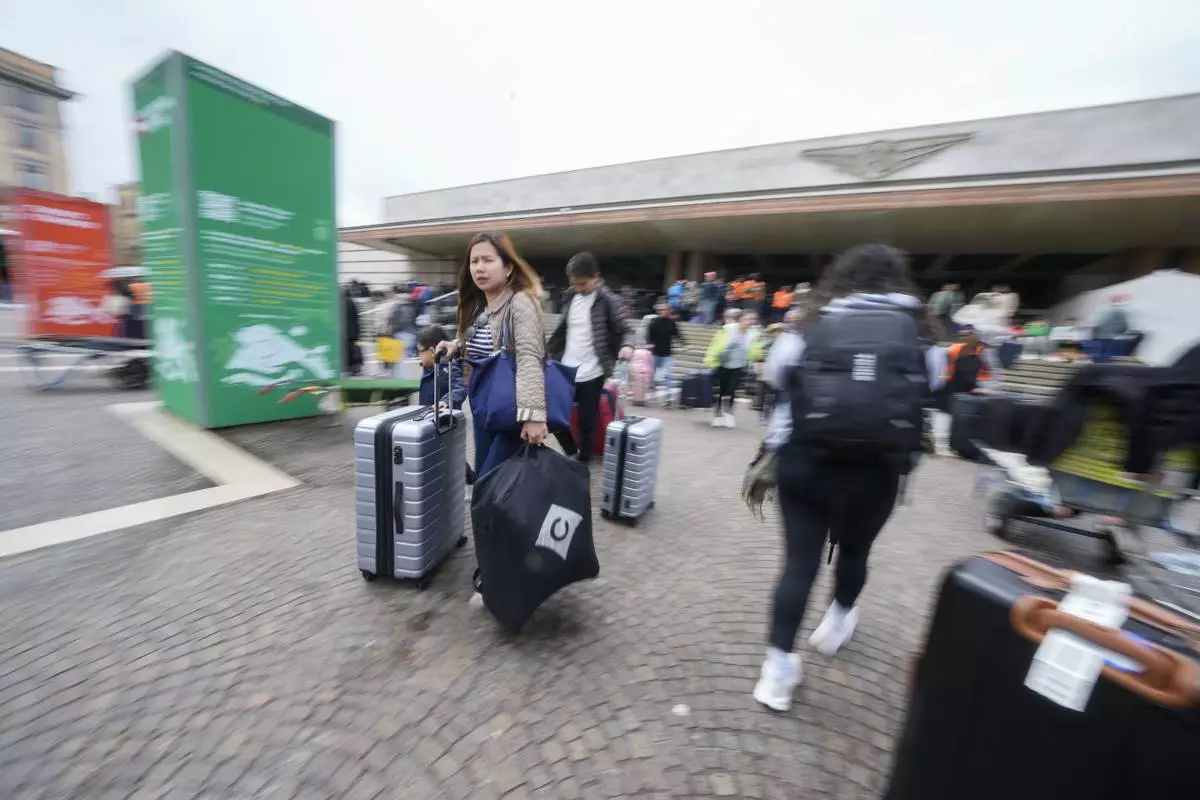
Tourists arrive at the main train station in Venice, Italy, Wednesday, April 24, 2024. The lagoon city of Venice begins a pilot program Thursday, April 25, 2024 to charge daytrippers a 5 euro entry fee that authorities hope will discourage tourists from arriving on peak days. Officials expect some 10,000 people will pay the fee to access the city on the first day, downloading a QR code to prove their payment. (AP Photo/Luca Bruno)
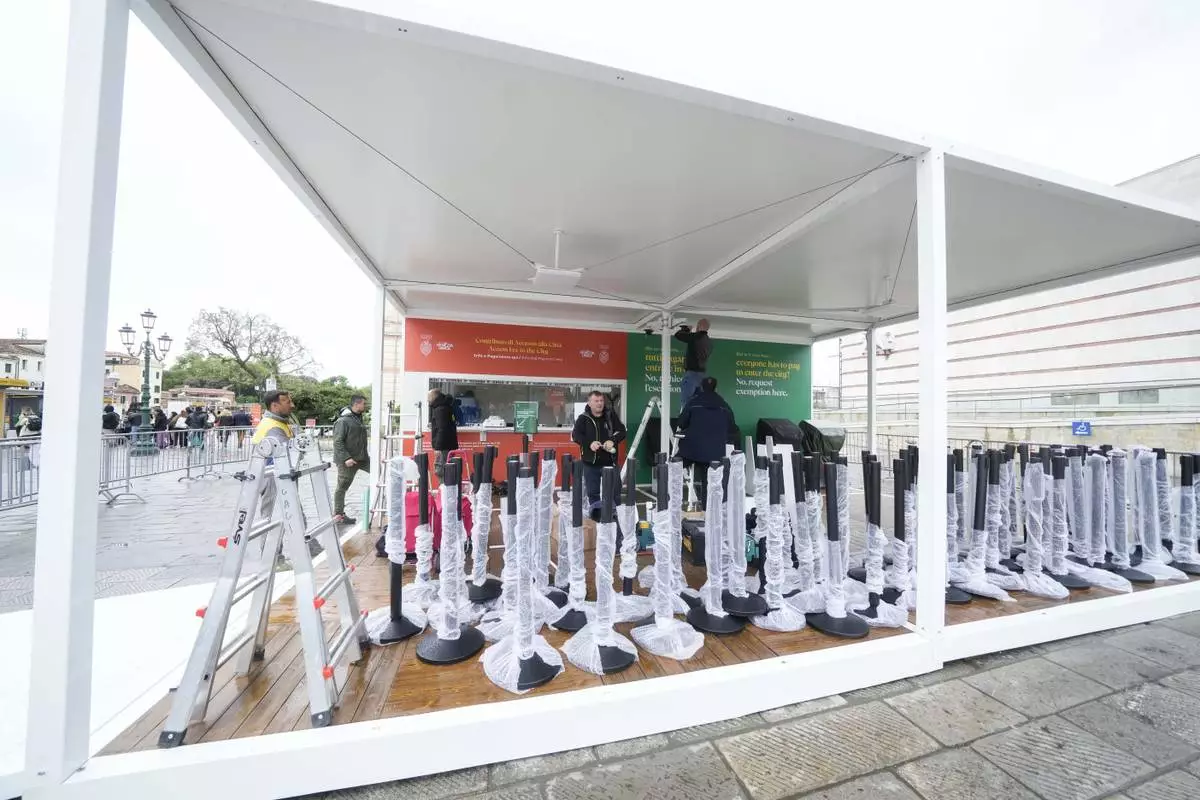
Workers prepare the tourist tax cashier desks outside the main train station in Venice, Italy, Wednesday, April 24, 2024. The lagoon city of Venice begins a pilot program Thursday, April 25, 2024 to charge daytrippers a 5 euro entry fee that authorities hope will discourage tourists from arriving on peak days. Officials expect some 10,000 people will pay the fee to access the city on the first day, downloading a QR code to prove their payment. (AP Photo/Luca Bruno)
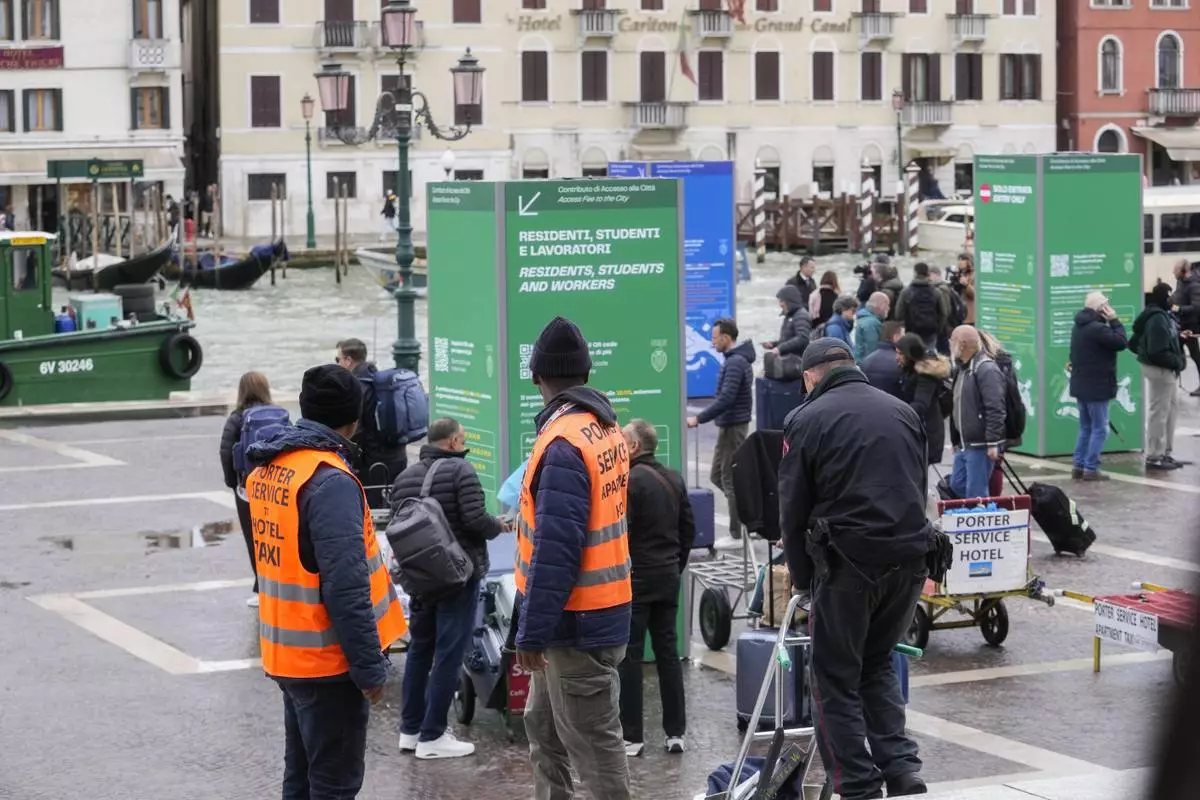
Porters wait for tourists outside the main train station in Venice, Italy, Wednesday, April 24, 2024. The lagoon city of Venice begins a pilot program Thursday, April 25, 2024 to charge daytrippers a 5 euro entry fee that authorities hope will discourage tourists from arriving on peak days. Officials expect some 10,000 people will pay the fee to access the city on the first day, downloading a QR code to prove their payment. (AP Photo/Luca Bruno)
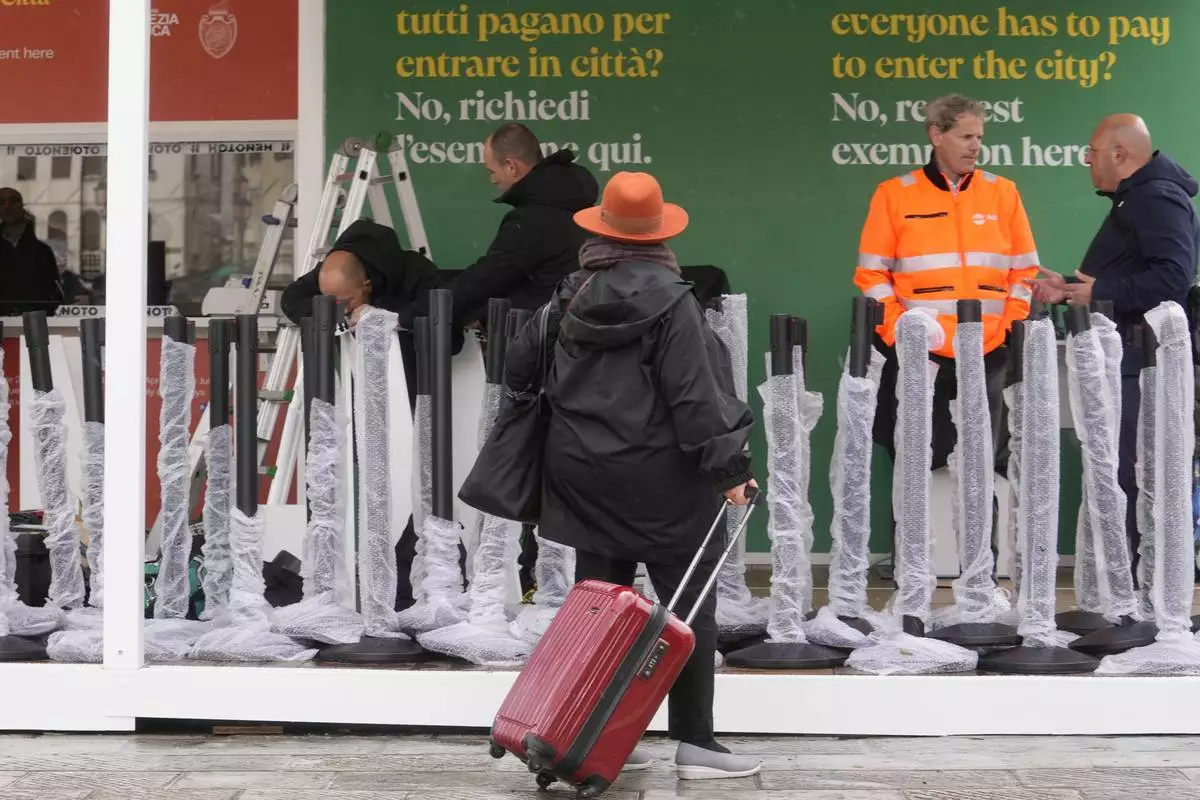
Workers prepare the tourist tax cashier desks outside the main train station in Venice, Italy, Wednesday, April 24, 2024. The lagoon city of Venice begins a pilot program Thursday, April 25, 2024 to charge daytrippers a 5 euro entry fee that authorities hope will discourage tourists from arriving on peak days. Officials expect some 10,000 people will pay the fee to access the city on the first day, downloading a QR code to prove their payment. (AP Photo/Luca Bruno)
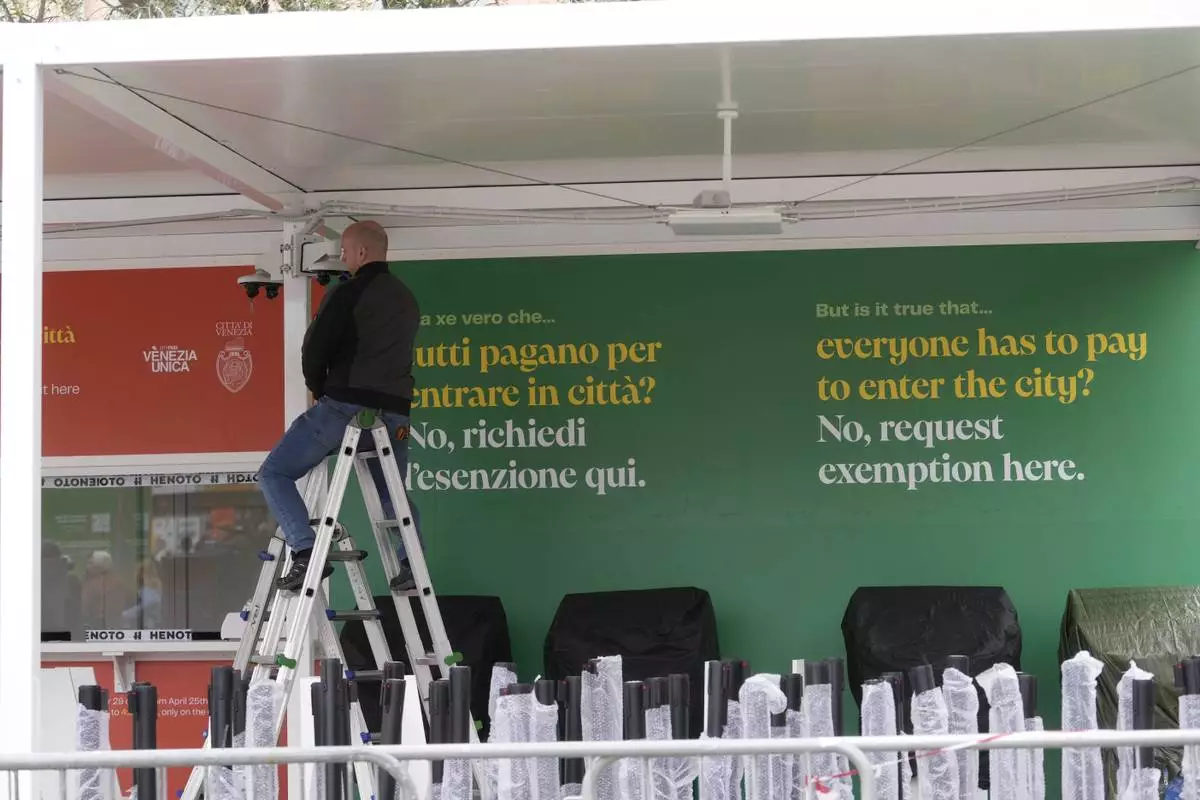
Workers prepare the tourist tax cashier desks outside the main train station in Venice, Italy, Wednesday, April 24, 2024. The lagoon city of Venice begins a pilot program Thursday, April 25, 2024 to charge daytrippers a 5 euro entry fee that authorities hope will discourage tourists from arriving on peak days. Officials expect some 10,000 people will pay the fee to access the city on the first day, downloading a QR code to prove their payment. (AP Photo/Luca Bruno)

Porters wait for tourists outside the main train station in Venice, Italy, Wednesday, April 24, 2024. The lagoon city of Venice begins a pilot program Thursday, April 25, 2024 to charge daytrippers a 5 euro entry fee that authorities hope will discourage tourists from arriving on peak days. Officials expect some 10,000 people will pay the fee to access the city on the first day, downloading a QR code to prove their payment. (AP Photo/Luca Bruno)
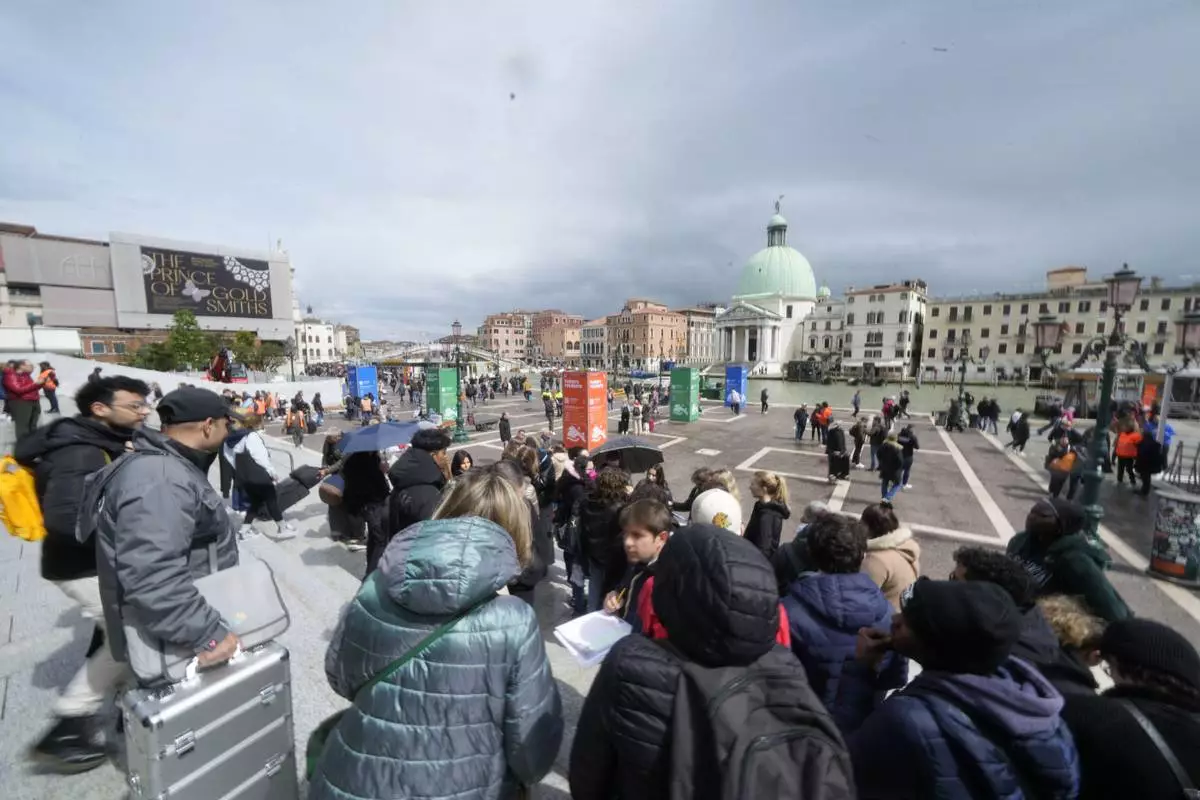
Tourists arrive outside the main train station in Venice, Italy, Wednesday, April 24, 2024. The lagoon city of Venice begins a pilot program Thursday, April 25, 2024 to charge daytrippers a 5 euro entry fee that authorities hope will discourage tourists from arriving on peak days. Officials expect some 10,000 people will pay the fee to access the city on the first day, downloading a QR code to prove their payment. (AP Photo/Luca Bruno)
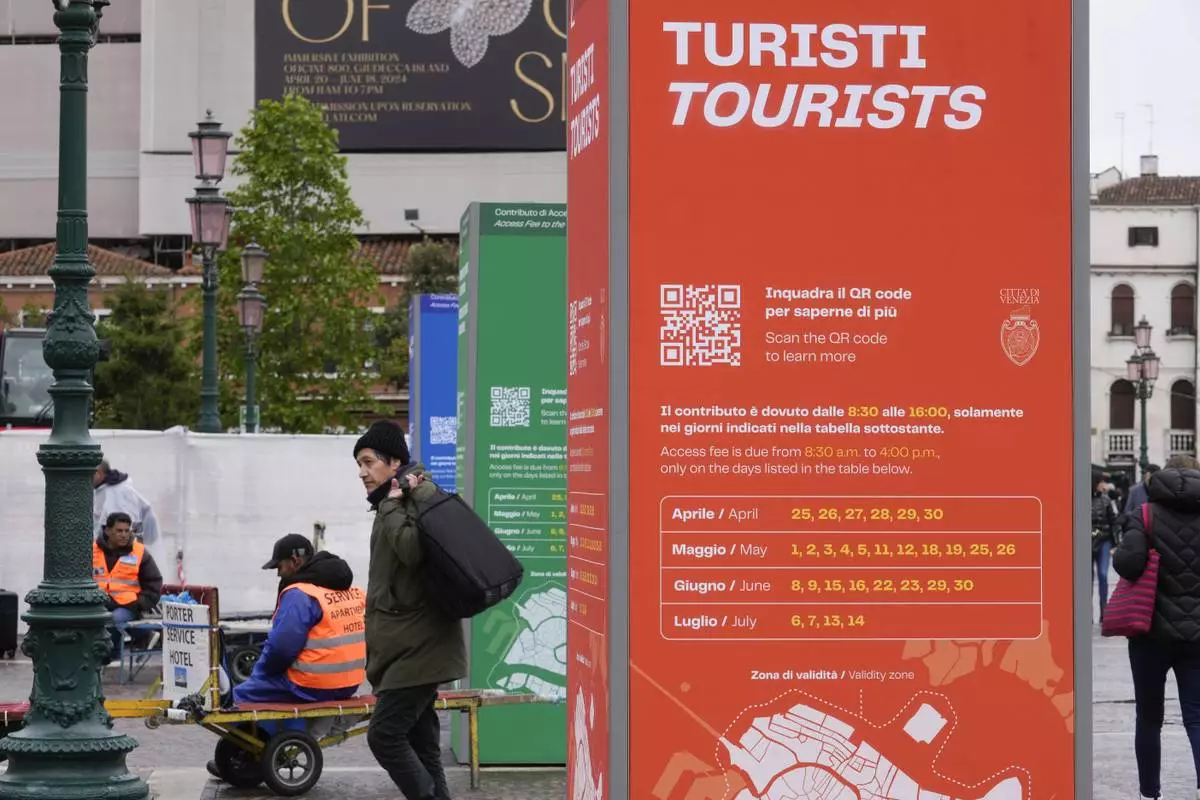
Tourist information boards are seen outside the main train station in Venice, Italy, Wednesday, April 24, 2024. The lagoon city of Venice begins a pilot program Thursday, April 25, 2024 to charge daytrippers a 5 euro entry fee that authorities hope will discourage tourists from arriving on peak days. Officials expect some 10,000 people will pay the fee to access the city on the first day, downloading a QR code to prove their payment. (AP Photo/Luca Bruno)
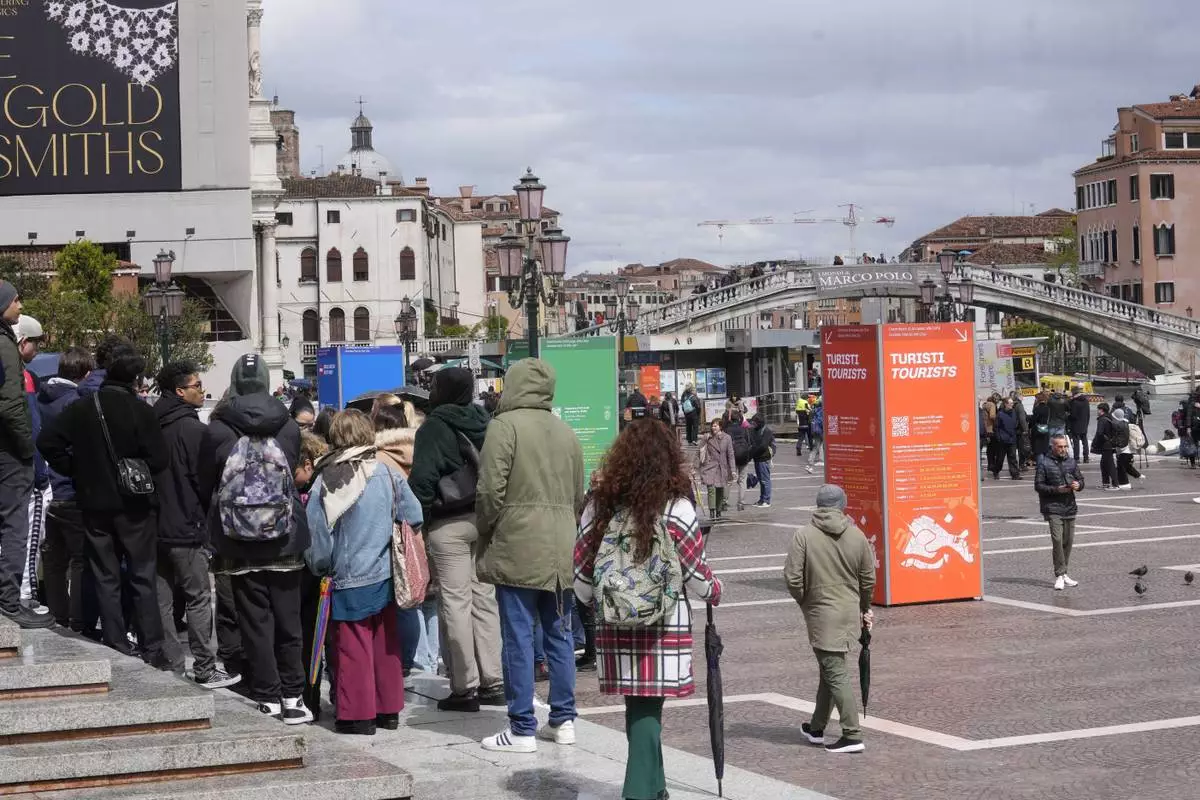
Tourists arrive outside the main train station in Venice, Italy, Wednesday, April 24, 2024. The lagoon city of Venice begins a pilot program Thursday, April 25, 2024 to charge daytrippers a 5 euro entry fee that authorities hope will discourage tourists from arriving on peak days. Officials expect some 10,000 people will pay the fee to access the city on the first day, downloading a QR code to prove their payment. (AP Photo/Luca Bruno)



























